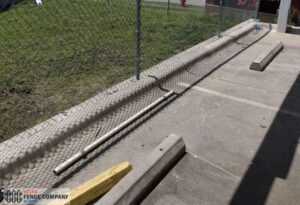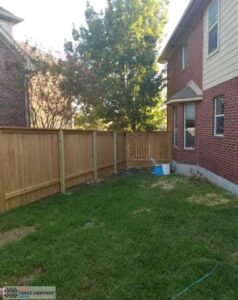Prep That Makes Stain Last: Moisture, Mill Glaze & Cleaning Sequences
TL;DR
If you plan to stain a fence and it fails in Austin by year two, prep—not product—is usually the culprit. Long-lasting results start with dry wood (target ≤15% moisture), removal of mill glaze on new cedar, and a clean–rinse–neutralize sequence that opens the grain without shredding it. Work in the cool part of the day, keep surface temps under ~95°F, back-brush every board, and protect the finish from sprinklers and dust while it cures. Want a dialed-in, site-specific plan? The team at Atlas Fence Company designs prep workflows for Austin’s heat, limestone dust, and hard water so your stain actually lasts.
Table of Contents
ToggleWhy Prep Matters More Than the Can

Two fences, same stain—one looks great at year three, the other chalks and fades by the second summer. The difference in fence staining s rarely the label; it’s the substrate condition and application environment. Stain is a system: wood moisture, clean/open grain, temperature, and cure protection. Miss one and you shorten the life of the whole finish.
And because prep quality compounds the value of good chemistry, we always pair this guide with our Austin-focused color/chemistry advice. If you’re still choosing a product, our homeowners’ explainer on how much stain is needed and picking the right finish in this climate is a helpful companion read: how to choose the best fence stain for Austin (mid-tone penetrating formulations win most west-facing battles).
Austin Factors That Wreck Stain Early
Austin is spectacular—and hard on finishes:
- Heat & UV: West- and south-facing areas can reach 120°F or higher in July. Hot boards flash carriers before penetration.
- Greenbelt pollen & dust: Spring “cedar sneeze” and hill-country dust load fibers with contamination that blocks stain.
- Hard water & sprinklers: City water leaves mineral crust that makes fresh stains look blotchy.
- Limestone fines: Post-drilling, throw alkaline dust on nearby boards; if you don’t rinse/neutralize, you stain the dust, not the wood.
- Wind: Afternoon gusts blow grit onto the wet stain, prematurely drying the leading edge and causing lap marks.
Good prep neutralizes the local enemies before they contact the finish.
Moisture: Numbers, Tools, and Timing
Penetrating stains need wood that will accept and hold the resin. That means moisture below the fiber saturation point and polymers that can actually lodge in the cell walls.
Targets (by substrate):
- New cedar: ≤ 15%
- Seasoned cedar (6+ months exposed): 12–15%
- Pressure-treated pine: ≤12–14% after seasoning (often 8–12+ weeks in our heat)
Tools:
A calibrated pin-type moisture meter is the only honest way to know. Take at least 10 readings per run, mixing heartwood/sapwood and sun/shade faces. Log the highs.
Timing:
- After washing/brightening, expect 24–48 hours of drying in warm weather; longer on the north/east faces and after cool fronts.
- Don’t chase the calendar. Chase the number.
Mill Glaze: What It Is and How to Remove It
Mill glaze is the slick, compressed surface left by high-speed planers. On new cedar pickets, it looks pretty—until stain beads on it like rain on a hood. In Austin, where heat already fights penetration, solid stain can be affected by mill glaze, which is a silent killer.
How to spot it:
- Water drips bead instead of darkening the board.
- The surface feels glassy and “closed” to the touch.
- The stain test swatch wipes off too easily.
Removal methods (best → acceptable):
- Oxalic/ascorbic brightener after a light alkaline clean, followed by a low-PSI rinse (opens grain without fuzz).
- Abrasive scuff with non-woven pads (quick, but go gently; you’re not sanding a table).
- Very light sodium percarbonate wash followed by brightener (works, but be careful not to raise fuzz).
Avoid: Aggressive sanding that closes fibers again and harsh acids without a preceding clean—both can create uneven absorption.
Cleaning Sequences (New Cedar vs. Weathered Fences)
A) New Cedar (installed ≤90 days)

Goal: Remove construction dirt, limestone dust, and mill glaze; even out color.
- Dry prep: Blow off dust/debris. Protect concrete, stone, and plants.
- Alkaline clean (light): Apply a mild wood cleaner (percarbonate-based or low-alkaline surfactant). Dwell 5–10 minutes—keep it wet.
- Gentle agitation: Use a soft brush in the grain direction; focus on latch areas and kick zones.
- Rinse (low PSI): 600–800 PSI max with a 40° nozzle, 12–18″ off the surface.
- Brighten/neutralize: Oxalic or citric acid solution to remove tannin/metal streaks and open the grain. Dwell 3–5 minutes.
- Final rinse: Same low PSI.
- Dry-down: 24–48 hours to moisture targets, then proceed to stain.
B) Weathered Fence (gray, 1–5 years old)
Goal: Remove gray oxidized fiber, mildew, minerals; restore pH and color.
- Dry prep: Scrape off mud daubers, tape, and any loose flake from prior film finishes.
- Active clean: Sodium percarbonate cleaner (or Pro Blend) to lift gray and organic buildup. Dwell 10–15 minutes, keep wet.
- Agitate: Medium bristle brush; avoid cross-graining.
- Rinse: 800–1000 PSI max, 40° nozzle, steady, overlapping passes. No “writing your name” on boards.
- Brighten: Oxalic/citric to neutralize alkalinity and dissolve mineral tracks from sprinklers.
- Final rinse: Until runoff runs clear and pH is near neutral.
- Dry-down: Hit the moisture targets before staining.
Mildew-heavy panels: Pre-treat with a wood-safe mildewcide per label, then follow the sequence above.
Chemistry 101: Cleaners, Brighteners, and What to Avoid
- Percarbonate cleaners (alkaline oxygen) lift gray fiber and organic soils without bleaching sound wood.
- Surfactant cleaners loosen sunscreen, oils, and dust without high alkalinity.
- Brighteners (oxalic/citric) restore pH after alkaline cleaning and remove iron/limestone discoloration. They also “unlock” that tight, mill-glazed sheen.
What to avoid:
- Straight bleach on cedar—it burns lignin, turns wood fuzzy and blotchy, and can corrode nearby hardware.
- High-alkaline deck strippers unless you’re removing a failed film finish (rare on fences). They over-etch fence-grade cedar.
- Mixing chemicals in the pump sprayer “to make it stronger.” Follow the TDS; stronger isn’t better if you tear fibers.
Surface Temperature & Shade Planning
In July, board temps spike well above air temps. Stain carriers flash off and pigments lock in unevenly.
- Work windows: Mornings 8–11 a.m. and shaded late-day (after 5 p.m.) are prime.
- Shade creation: Use a pop-up shade or time the job as the house casts shade across the fence line.
- Touch test: If you can’t hold your hand flat on the board for 3 seconds, it’s too hot to stain.
- Target: Keep the surface under ~95°F at application.
Rinsing: PSI, Nozzles, and “Fuzz Control”
You’re cleaning a vertical wall of fibers, not stripping a deck.
- Nozzle: 40° (white) fan tip; never a zero-degree pinpoint.
- Distance: 12–18″ off the board; keep the fan moving at a walking pace.
- Pressure: 600–1000 PSI is enough. More PSI equals more fuzzing (raised grain), which soaks stain unevenly and feels rough.
- Direction: Work top-down in overlapping passes; finish with a long rinse to carry chemistry into the grass, not onto stone.
Dry-Down Windows & “No-Go” Conditions
Even perfect cleaning fails if you trap water under the stain.
Do stain when:
- Moisture readings meet targets (≤15% cedar; ≤12–14% seasoned PT).
- Dew points are low enough that the film won’t dew-blush at night.
- Wind is light—so your wet edge stays wet.
Do NOT stain when:
- Sprinklers will hit the fence within 48 hours.
- Wind is sandblasting dust from a greenbelt or construction site.
- Rain is inside a 24-hour window post-stain (penetrating systems still need time to set).
- Boards are sun-hot, or the RH is so low that the wet edge keeps flashing off.
Sample 2-Day Prep Schedule
(Adjust for fence size and exposure; this assumes west-facing backyard sections.)
Day 1 – Prep & Clean
- 7:30 a.m. Walk the line, mark soft boards/hardware to tighten, and confirm sprinkler shutdown.
- 8:00 a.m. Dry prep & masking.
- 8:30 a.m. Apply cleaner (percarbonate or mild surfactant) to first 30-40 linear feet; dwell 10 min.
- 8:45 a.m. Light brush; keep wet.
- 9:15 a.m. Low-PSI rinse.
- 9:45 a.m. Brightener/neutralizer; 3–5 min dwell.
- 10:00 a.m. Final rinse.
- 10:30 a.m. Moisture spot checks (for baseline).
- 11:00 a.m. Repeat sequence in manageable sections until noon shade line ends.
- Afternoon: Hardware fixes, gate alignment, and site cleanup while panels dry.
Day 2 – Verify & Stain (cool window)
- 7:30 a.m. Moisture readings: log high/low. Target met? Proceed.
- 8:00–11:00 a.m. Stain application with brush/roll + back-brush on every board. Maintain wet edge; work in shade.
- Midday pause if the boards heat; resume after 5:00 p.m. in the shade.
- Post-stain: Cones/tape, “no sprinkler” tags, and dust control (blow off patio dust so it doesn’t drift).
QA Checklist Before You Open the Can
- ✅ Moisture at/under target across sample points
- ✅ Mill glaze removed (water darkens, doesn’t bead)
- ✅ Even color after brightener—no gray “shadows” in valleys
- ✅ Surface temp under ~95°F
- ✅ Wind manageable; shade plan in place
- ✅ Sprinklers off for 48 hours; forecast clear
- ✅ Clean shoes, clean tools, fresh brushes—contamination sneaks in here
Maintenance After Stain: Keep It Looking Fresh

Prep doesn’t end on stain day. Small habits stretch service life:
- Spring wash: Low-pressure rinse + mild cleaner to knock down pollen and minerals.
- Spot care: If sprinklers hit one bay, wipe minerals with a mild acid wash and rinse—don’t let it crust.
- Trim plants 6–8″ off the fence for airflow; greenery against boards traps moisture and makes dirt stripes.
- Refresh cadence: In our climate, a penetrating stain typically needs a light refresher at 24–36 months on west/south faces; 36–48 months on north/east faces. Because it’s penetrating, you won’t be scraping—clean, brightening, re-coating, done.
If you’d rather stay hands-off, our professional fence staining service in Austin keeps you on that cadence automatically with prep tuned to sun, soil, and wind. (We schedule shade windows and shut sprinklers so the cure goes right the first time.)
FAQs
Do a quick wipe test: Wipe a rag on a shaded board. If it feels cool/damp and darkens, then rebounds in minutes, it’s still carrying water. Always trust the meter, but use your senses to spot trouble areas.
Usually not. Remove mill glaze with a clean → brighten sequence and light scuffing only if needed. Heavy sanding can actually close fibers and reduce absorption.
If it’s a penetrating stain that has eroded, the clean/brighten sequence works. If you’re dealing with a peeling film when applying stain , that’s a different animal—selective stripping might be required on those bays before returning to a penetrating system.
Not in Austin most days. Morning wash → afternoon stain often fails because the sun drives surface heat while internal moisture remains. After the first coat, give it 24–48 hours before applying the second coat and verify with a meter.
Hot boards or uneven brightener neutralization. Keep temps down, rinse evenly, and back-brush to even the load.
Ready for a Site-Specific Prep Plan?
If you want a finish for your staining project that still looks good after two Austin summers, meticulous prep is the multiplier. We measure moisture, map shade windows, remove mill glaze the right way, and stage dust & sprinkler controls so stain can do its job. For new builds, we coordinate framing and dry-down with our install crew so prep and finish lock in together—no guesswork.
Call (512) 366-8108 or start here to schedule a walkthrough and get a precise, Austin-tuned prep + stain spec: request a fence and gate estimate.
